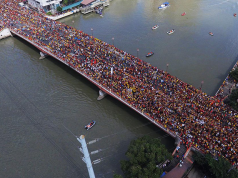The newly restored Jones Bridge which cost around P20 million to complete was a refreshing piece of news after reports of alleged overspending for the Philippines’ hosting of the Southeast Asian Games.
Jones Bridge, once touted as the Queen of Bridges in Manila, spans the Pasig River and connects Binondo and Intramuros.
It underwent its share of wear and tear since it was first built in 1919, thus marking its centennial anniversary this year.
Manila Mayor Francisco “Isko” Moreno and Vice Mayor Dr. Honey Lacuna-Pangan led the inauguration ceremony of the historic bridge last November 25. It was temporarily closed from traffic during the rehabilitation.
LOOK: Manila City Mayor Francisco "Isko Moreno" Domagoso and Vice Mayor Dr. Honey Lacuna-Pangan led the inauguration of…
Posted by Manila Public Information Office on Monday, November 25, 2019
The city government of Manila reportedly received P20 million from Chinese-Filipino businessmen for this project.
New lampposts in pre-war designs were also placed along the bridge. The project team consulted Jerry Acuzar, the architect behind the historical resort Las Casas Filipinas de Acuzar in Bataan, for it.
Moreover, one of the three historical sculptures called the La Madre Filipina or The Filipina Mother also returned to Jones Bridge, its original location.
Tourism Secretary Bernadette Puyat and Moreno signed a memorandum of agreement for the turnover of the statue from Rizal Park where it was relocated in the 1960s.
The La Madre Filipina sculptures were part of the four-piece work of sculptor-painter Ramon Lazaro Martinez. They once adorned the pillars of the bridge when they were unveiled in 1921.
Moreno cited the bridge’s purpose of connecting two of Manila’s oldest communities.
“One of the challenges of Manila is that it is divided by creeks and rivers and the Jones Bridge symbolizes Manila’s commerce and history. Ang tulay na ito ay nagdurugtong sa dalawang naunang komuninad sa Maynila—ang Binondo at Intramuros,” Moreno said.
Meanwhile, Puyat hoped that the other two La Madre Filipina statues will be allowed to return to their home in the near future.
The other two relics are currently installed at the Court of Appeals compound in Ermita, Manila.
“We appreciate Manileños feeling of nostalgia for Old Manila and I trust that the Court of Appeals and the National Historical Commission of the Philippines will also agree to have the last two original La Madre Filipinas back at the Jones Bridge soon,” Puyat said.
According to an old report from the Bureau of Public Works Bulletin, the La Madre sculptures symbolize democracy, justice, gratitude and progress.
Comments on the restored structure were mostly filled with praises for the efforts of the local government to preserve the capital’s history.

Quick history
Prior to the Jones Bridge, another infrastructure called the Puenta de España (Bridge of Spain) stood in its place. It was, however, severely damaged by floods during the American occupation.
In 1916, the U.S. government decided to create a new one and commissioned Juan M. Arellano, who also designed the Manila Post Office and the Metropolitan Theater.
This bridge would then be called the William A. Jones Memorial Bridge or Jones Bridge, as a tribute to William Jones and Jones Law, which was enacted to grant the Philippines temporary independence.
It was among the many structures in Manila that were destroyed during World War II and then rebuilt again in 1950.






